Essay on Kashmir Issue with Outline and Quotations
This post contains an Essay on Kashmir Issue with Outline and Quotations for the students of Class 10, Class 12, FSc, B.A, BSc, Graduation, and others. The same essay could be written under the title Essay on Kashmir Issue or Few Lines about Kashmir. There are many other important essays for different Classes are available here as well. Click here for more Essays. Kashmir Conflict is between India and Pakistan. Now, this issue is a current affair nowadays and this Essay on Kashmir Problem is very important for exams. Here are 2 essay examples the first one is with outline and quotes and the second one is simple and easy.

Kashmir Issue Essay with Outline and Quotes for Students
- A bone of contention.
- The right of self-determination.
- The inexpressible miseries of the Kashmiris.
- India is projecting the struggle as “Muslim Fundamentalism.”
- UNO should play an active role.
“Liberty will not descend to a people; It is a blessing that must be earned Before it can be enjoyed.”
Kashmir is a bone of contention between Pakistan and India. The Kashmir issue is the biggest hindrance in the normalization of relations between Pakistan and India. The two countries have fought two full-fledged wars over this issue. In view of its geopolitical significance, India desired to acquire Kashmir when the partition of the sub-continent became inevitable circumstances when the Kashmiri Muslims revolted against the evil designs of India.
“True independence and freedom can only exist in doing what’s right.” (Brigham Young)
Pakistan is of the view that only the people of Kashmir have a right to determine the future of Kashmir. The UN resolutions of August 13, 1948, and January 5, 1949, which were accepted both by India and Pakistan provided for the holding a plebiscite under the UN auspices to settle the Kashmir issue.
You may also like: Essay on Qaid e Azam Muhammad Ali Jinnah
The people of Kashmir have been suffering from inexpressible miseries since 1948. The unending curfew, rape cases, torture cells and crushing of their resources are only the slight expression of their miseries. A new hell can be witnessed in this old heaven. India is projecting the struggle in Kashmir as “Muslim Fundamentalism”. India cannot throw the dust into the eyes of the World Community by labeling the Kashmir Liberation Movement as “Religious fanaticism”. In fact, the Kashmiri people along with their Islamic aspirations are fighting for the protection of their political, religious, cultural and economic rights. It is the expression of the entire community. The Indian authorities have failed to understand the core issue and are trying to deal with it as that of law and order. They link it to terrorism sponsored by Pakistan.
“Be an independent thinker at all times, and ignore anyone who attempts to define you in a limiting way.” ( Sherry Argov)
The time has come when UNO should play an active role as it has played an Iraq-Kuwait case. The resolutions on Kashmir are yet to be fully implemented. The UNO has lost its repute as peacekeeping and peacemaking body. The unending struggle of the freedom fighters has proved that the will of people cannot be suppressed. It is the moral obligation of the International Community to rescue the innocent Kashmiris from the brutalities, cruelties and atrocities of the occupation army of India. The Muslim Ummah should also come out of its slumber and prove it to the world that Islam is a force which cannot be suppressed.
Essay on Importance of Education is also available here.
02. Essay on Kashmir Issue and its Solution
Kashmir Dispute / Problem / Issue and Its solution
Kashmir was once said to be a heaven on the earth. But at present, the situation is totally different and the circumstances are worst. In Occupied Kashmir, raping of the Muslim girls and women by the armed forces of Hindustan has become common. The Muslim men and women, and boys and girls are being persecuted to death into the torture cells by the Indian army soldiers.
The innocent Kashmiri Muslims are being killed mercilessly on a large scale. In fact, the Valley of Occupied Kashmir has become a slaughter-house of the Kashmiri Muslims. At present, occupied Kashmir is presenting a terrible spectacle.
The U.N.O. passed two resolutions in 1948 and 1949, which were accepted both by Pakistan and Hindustan, for the holding of a plebiscite under the supervision of U.N.O. to settle the Kashmir issue forever. These two resolutions are still hanging fire.
The Western countries are playing the most condemnable role regarding the Kashmir issue. The politicians of these countries seem to be worried about the pollution, caused by smoke and noise, but it is a matter of great regret that they are not paying any attention to the pollution caused by the blood of the innocent Muslims of occupied Kashmir.
The Hindustan Government has so far used all the possible tools to crush the freedom movement of the Kashmiri Muslims in their own homeland. The rulers of Hindustan have so far failed to understand the real problem. They are trying to deal with the freedom-movement of the Kashmir’s as terrorism against Hindustan.
In fact, the freedom-movement of the Kashmiri’s is the expression of the entire community of Kashmir. The students, the traders, the house-wives, the farmers and the politicians are all one in this freedom-movement. The daily killing of innocent Kashmiris has not demoralized them. It has rather given them a new courage, a new zeal, and new confidence to fight for their rights of self-determination.
The Law enforcing Agencies of Hindustan has crippled countless Muslims in the occupied Kashmir. It appears as if Hindustan will never be prepared to recognize the right of self-determination of the Kashmiris as the rulers of Hindustan are not ready to negotiate and solve the Kashmir Issue under Simla Agreement and U.N.O resolutions.
To conclude, the international community must pressurize Hindustan to accept the justified demand of the Kashmiris. It must impose economic restrictions on Hindustan. It must also use force under U.N.O. The time has now come when U.N.O must play an effective role to solve the Kashmir issue as it has played in Iraq-Kuwait case, otherwise, it can lose its vitality as peace-keeping and peace-making organization in the world.
- More Essays on Ilmihub.
- Essay on Democracy in Pakistan with Quotations
- Essay on Terrorism in Pakistan with Quotations
- Essay on Overpopulation with Outline
- Essay on Qaid-e-Azam Muhammad Ali Jinnah with Quotes and Outline
- Essay on Importance of Education in Life with Outline and Quotes
- More In English Essays
Essay Writing 101: The Basics That Every Writer Should Know
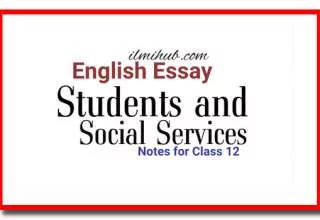
Students and Social Service Essay with Quotations
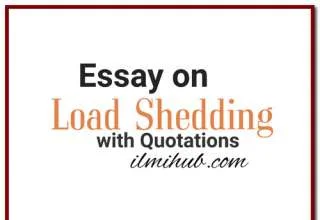
Load Shedding in Pakistan Essay – 1200 Words
One comment.
June 6, 2023 at 6:14 am
It’s very informative Thank you ☺️
Leave a Reply Cancel reply
Your email address will not be published. Required fields are marked *

- Privacy Policty
- Terms of Service
- Advertise with Us
What’s Article 370? What to know about India top court verdict on Kashmir
The Supreme Court backs Prime Minister Narendra Modi’s removal of Indian-administered Kashmir’s semi-autonomy.
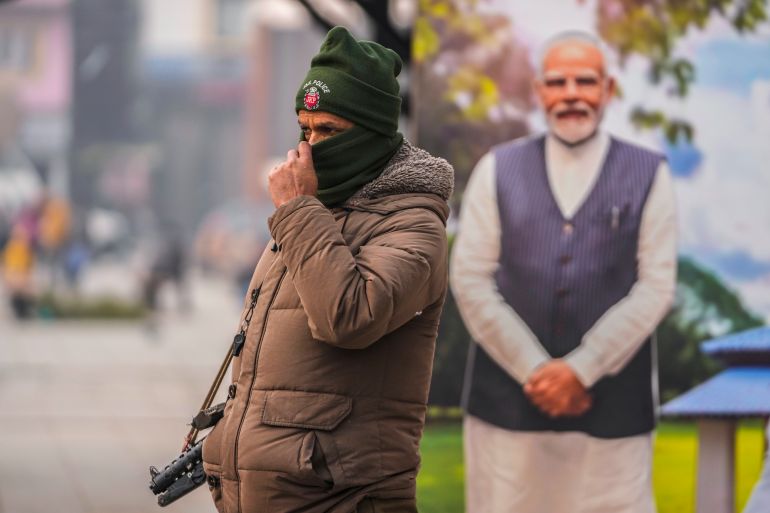
In a major setback to Kashmiri political groups, India’s Supreme Court has upheld a 2019 decision by Prime Minister Narendra Modi’s government to revoke special status for Indian-administered Kashmir, which gave it a degree of autonomy.
The disputed Himalayan region is claimed in full although ruled in part by both India and Pakistan since their independence from Britain in 1947. The nuclear-armed neighbours have fought three of their four wars over it since then.
The court hearings began in August on a petition filed by Kashmiri individuals and groups.
The verdict is a big boost for the governing Hindu nationalist Bharatiya Janata Party (BJP) ahead of general elections due in May. The 2019 decision by the BJP was a campaign promise to end Article 370, which granted special status to the disputed Himalayan region.
Here is all you need to know about the issue:
What does Monday’s verdict say?
In its ruling, the Supreme Court said Jammu and Kashmir should be restored to the same statehood as any other Indian state – with no separate autonomy rights – “at the earliest and as soon as possible”.
The five-judge constitutional bench of the Supreme Court ruled the region’s special status had been a “temporary provision” and removing it in 2019 was constitutionally valid.
“Article 370 was an interim arrangement due to war conditions in the state,” Chief Justice DY Chandrachud said, referring to the provision in the Indian Constitution that provided the special status after Muslim-majority Kashmir’s Hindu ruler signed an agreement in 1947 to join India.
As part of the Instrument of Accession, India allowed Kashmir to retain its own constitution, flag and criminal code. Kashmir had its own prime minister and president until 1953 when New Delhi jailed its prime minister, Sheikh Abdullah, and abolished the post in what it said were efforts to integrate the Muslim-majority region with the rest of India.
Kashmir has been at the heart of more than 75 years of animosity between India and Pakistan.
Pakistan claims Kashmir as its own territory, saying the Muslim-majority area should have been part of the new state of Pakistan, created in 1947 when British colonial rule ended in the partition of the Indian subcontinent.
The First Kashmiri War broke out soon after partition and ended in 1949 with a United Nations-mediated ceasefire that divided Kashmir into Pakistani- and Indian-administered regions.
What is Article 370?
Article 370 , which came into effect in October 1949, granted Kashmir autonomy of internal administration, allowing it to make its own laws in all matters except finance, defence, foreign affairs and communications.
The Indian-administered region established a separate constitution and a separate flag and denied property rights in the region to outsiders.
Article 35A, a further provision added to Article 370 in 1954, empowered state lawmakers to ensure special rights and privileges for permanent residents of the state.
With the repeal of Article 370, Article 35A was also scrapped, allowing non-Kashmiris to buy property in the region and raising fears that India is trying to engineer a “demographic shift” in the Muslim-majority region.
In 2019, Modi’s government also bifurcated Kashmir into two regions – Jammu and Kashmir in the west and Ladakh in the east – to be ruled directly from New Delhi. Kashmir lost its flag, criminal code and constitution enshrined in Article 370.
No regional elections have been conducted in the two regions since then, but the Supreme Court ordered Indian-administered Kashmir to hold local legislative elections by September 30 next year.
What are the reactions to this verdict?
Modi called the judgement “a beacon of hope, a promise of a brighter future and a testament to our collective resolve to build a stronger, more united India”.
“The court, in its profound wisdom, has fortified the very essence of unity that we, as Indians, hold dear and cherish above all else,” he said in a post on X.
Challengers of his government’s 2019 decision maintained that only the Constituent Assembly of Indian-administered Kashmir could decide on the special status of the region and contested whether the Indian Parliament had the power to revoke it.
“Disappointed but not disheartened,” Omar Abdullah, a former chief minister and vice president of the Jammu & Kashmir National Conference party, posted on X. “The struggle will continue. It took the BJP decades to reach here. We are also prepared for the long haul.”
Disappointed but not disheartened. The struggle will continue. It took the BJP decades to reach here. We are also prepared for the long haul. #WeShallOvercome #Article370 — Omar Abdullah (@OmarAbdullah) December 11, 2023
Mehbooba Mufti, another former chief minister and president of the Jammu and Kashmir People’s Democratic Party, echoed those views. “The people of J&K are not going to lose hope or give up. Our fight for honour and dignity will continue regardless. This isn’t the end of the road for us,” she posted on X.
The people of J&K are not going to lose hope or give up. Our fight for honour and dignity will continue regardless. This isn’t the end of the road for us. pic.twitter.com/liRgzK7AT7 — Mehbooba Mufti (@MehboobaMufti) December 11, 2023
Many Kashmiris view the 2019 decision as an annexation, saying new laws were designed to change the region’s demographics. Members of minority Buddhist communities initially welcomed the move, but many of them later expressed fear of losing land and jobs in the Himalayan area.
- Skip to primary navigation
- Skip to main content
- Skip to primary sidebar
UPSC Coaching, Study Materials, and Mock Exams
Enroll in ClearIAS UPSC Coaching Join Now Log In
Call us: +91-9605741000
Kashmir Issue – Understand the multiple dimensions
Last updated on July 9, 2024 by Alex Andrews George
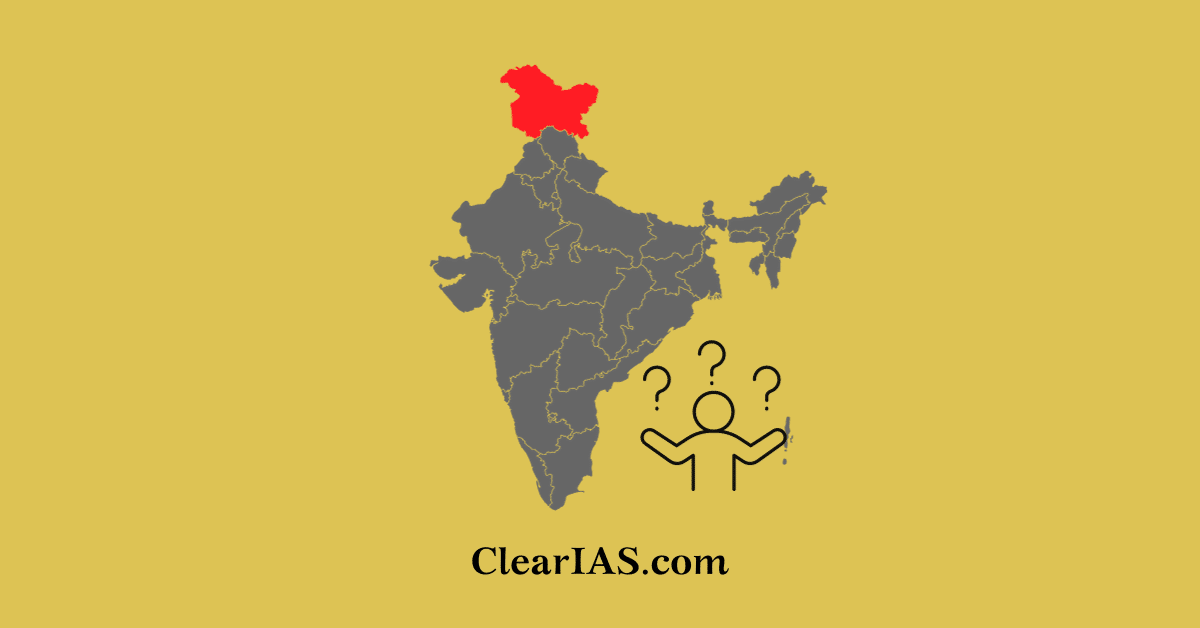
Table of Contents
Was Kashmir an independent nation? Learn the history of Kashmir
Subscribe to the ClearIAS YouTube Channel for more informative videos on UPSC preparation, tips, and strategies. Stay updated with our latest content and enhance your exam readiness.
Kashmir, and adjacent areas like Gilgit, Jammu, and Ladakh – were part of the different empires at different times. Over the years, this area was under the control of Hindu rulers, Muslim emperors, Sikhs, Afghans, and Britishers.
During the period before AD 1000, Kashmir was an important center of Buddhism and Hinduism. Many dynasties like Gonanditya, Karkota, and Lohara ruled Kashmir and surrounding areas of North-western India.
The Hindu dynasty rule which extended until 1339 was replaced by the Muslim rule by Shah Mir who became the first Muslim ruler of Kashmir, inaugurating the Shah Mir dynasty . A few centuries later, the last independent ruler Yusuf Shah Chak was deposed by the Mugul emperor Akbar the Great.
Akbar conquered Kashmir in 1587, making it part of the Mughal Empire . Subsequently, the Mughal ruler Aurangzeb expanded the empire further.
👉 Which year are YOU targeting for success in the IAS/IPS/IFS Exam? 🚀
(1) ⇒ UPSC 2025: Prelims cum Mains
(2) ⇒ UPSC 2026: Prelims cum Mains
(3) ⇒ UPSC 2027 Prelims cum Mains
Tip: Know more about ClearIAS Courses (Online/Offline)
Thus, it can be seen that under the Mughal rule, which extended nearly all of the Indian subcontinent, Kashmir was an integral part of India – however, not an independent nation .
Also read : Ladakh Statehood
Kashmir Region – After the Mughals
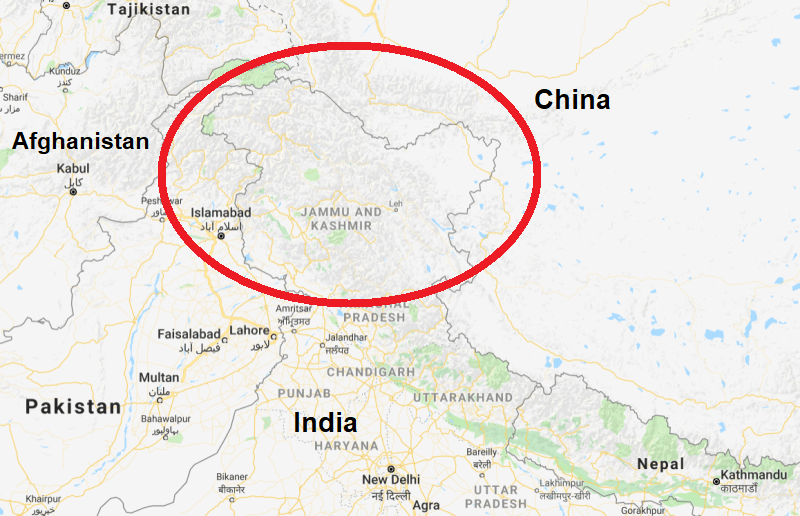
Aurangzeb’s successors were weak rulers. Later Mughals failed to retain Kashmir. After Mughal rule , it passed to Afghan, Sikh, and Dogra rule.
In 1752, Kashmir was seized by the Afghan ruler Ahmed Shah Abdali. The Afghan Durrani Empire ruled Kasmir from the 1750s until 1819 when Sikhs , under Ranjit Singh, annexed Kashmir and ended the Muslim rule.
By the early 19th century, Sikhs under Maharaja Renjith Singh took control of Kashmir. He had earlier annexed Jammu. The Sikhs ruled Kashmir until they were defeated by the British (First Anglo-Sikh War) in 1846.
After that Kashmir became a princely state of the British Empire – under the Dogra Dynasty.
Jammu and Kashmir – as a princely state of the British Empire
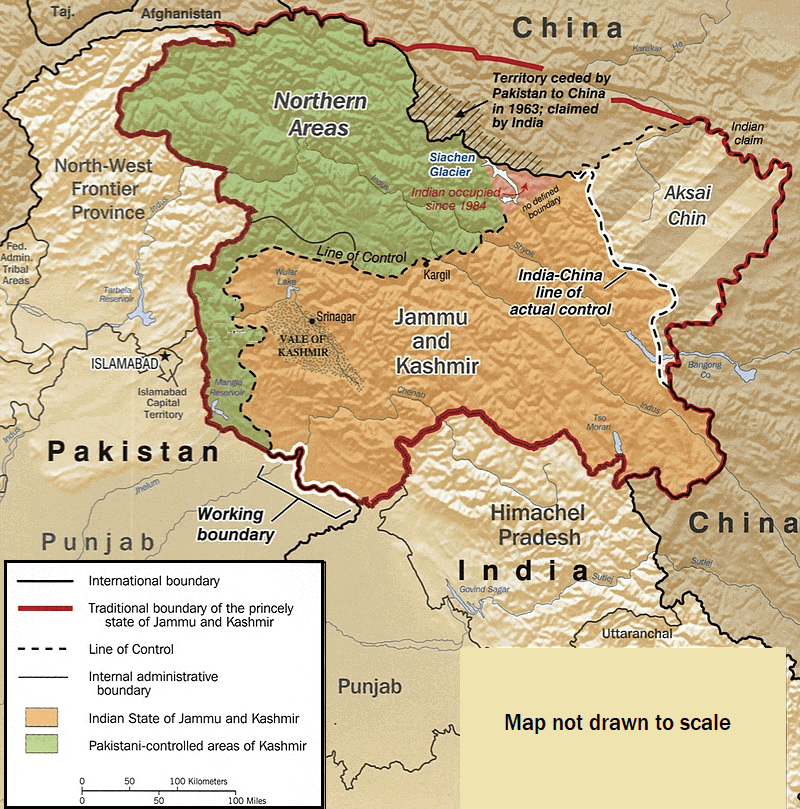
Maharaja Gulab Singh of the Dogra Dynasty signed the ‘Treaty of Amritsar’ with the British East India Company in 1846. Under this treaty, he paid Rs. 75 lakhs to the East India Company in 1846 in exchange for Kashmir and some other areas. Jammu and Kashmir as a single entity was unified and founded (1846).
Zorawar Singh, a General in the Dogra Anny later led many campaigns in the northern areas like Ladakh, Baltistan, Gilgit, Hunza, and Yagistan, consolidating smaller principalities. He expanded the dominions of Maharaja Gulab Singh.
However, Jammu and Kashmir, from 1846 until 1947, remained a princely state ruled by the Jamwal Rajput Dogra Dynasty. Like all other princely states in India then, Kashmir too enjoyed only partial autonomy, as the real control was with the British.
Also read: Special Category Status
The ruler’s stand (at the time of Partition)
During the time of partition of British India (1947), Jammu and Kashmir (J&K) was a Princely State. Britishers had given all princely states a choice – either to join India to join Pakistan or even to remain independent.
The ruler of Kashmir during that time (1947) was Maharaja Hari Singh, the great-grandson of Maharaja Gulab Singh. He was a Hindu who ruled over a majority-Muslim princely state.
He did not want to merge with India or Pakistan.
Hari Singh tried to negotiate with India and Pakistan to have an independent status for his state. He offered a proposal of a Standstill Agreement to both the Dominion, pending a final decision on the State’s accession. On August 12, 1947, the Prime Minister of Jammu and Kashmir sent identical communications to the Governments of India and Pakistan.
Pakistan accepted the offer and sent a communication to J&K Prime Minister on August 15, 1947. It read, “The Government of Pakistan agrees to have Standstill Agreement with Jammu and Kashmir for the continuation of existing arrangements …”
India advised the Maharaja to send his authorized representative to Delhi for further discussion on the offer.
What were the Kashmiri people’s aspirations in 1947?
Kashmiri people took part extensively in the Indian Nationalist Movement. They not only wanted to get rid of British rule but also never wanted to be under the rule of the Dogra dynasty once the nationalist movement achieved its mission. The Kashmiris had preferred democracy to monarchy.
Jammu and Kashmir was always a secular state – with a history of Hindu, Muslim, and Sikh rule. Even though the majority population was Muslims, it then had a significant Hindu population as well.
India in 1947 had suggested conducting a plebiscite to know the aspirations of Kashmiri people. With tall leaders of Jammu and Kashmir like Sheik Abdullah on its side, cherishing the common values – secularism, democracy, and pan-India nationalism – India was confident to win the Plebiscite if it was held in 1947.
India’s stand with Junagadh, another princely state, was also to conduct a plebiscite. In 1947, upon the independence and partition of India, the last Muslim ruler of the Junagadh state, Muhammad Mahabat Khanji III, decided to merge Junagadh into the newly formed Pakistan. The majority of the population were Hindus. The conflict led to many revolts and also a plebiscite, resulting in the integration of Junagadh into India.
However, the Pakistan attack on Kashmir in October 1947 changed all dynamics. The exact aspirations of Kashmiri People at that time is still unknown – as a plebiscite or referendum was never held.
The Pakistan Invasion of Kashmir in 1947
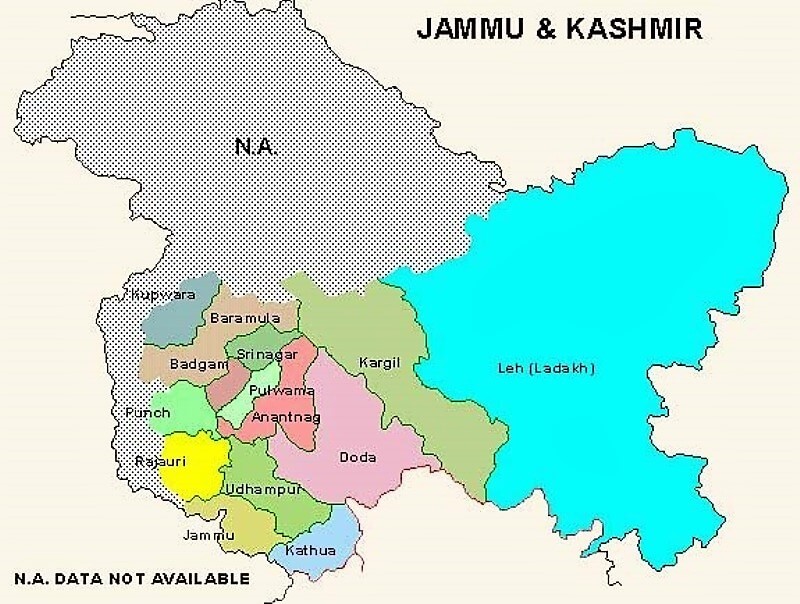
Pakistan, though entered into a Standstill Agreement with Jammu and Kashmir, had an eye on it. It broke the Standstill Agreement by sponsoring a tribal militant attack in Kashmir in October 1947.
Pashtun raiders from Pakistan invaded Kashmir in October 1947 and took control over a large area. Hari Singh appealed to the Governor General of free India, Lord Mountbatten for assistance.
India assured help on the condition Hari Singh should sign the Instrument of Accession. Maharaja Hari Singh signed the instrument of accession with India (1947). It was also agreed that once the situation normalized, the views of the people of J&K will be ascertained about their future.
Jammu and Kashmir signs the Instrument of Accession with India
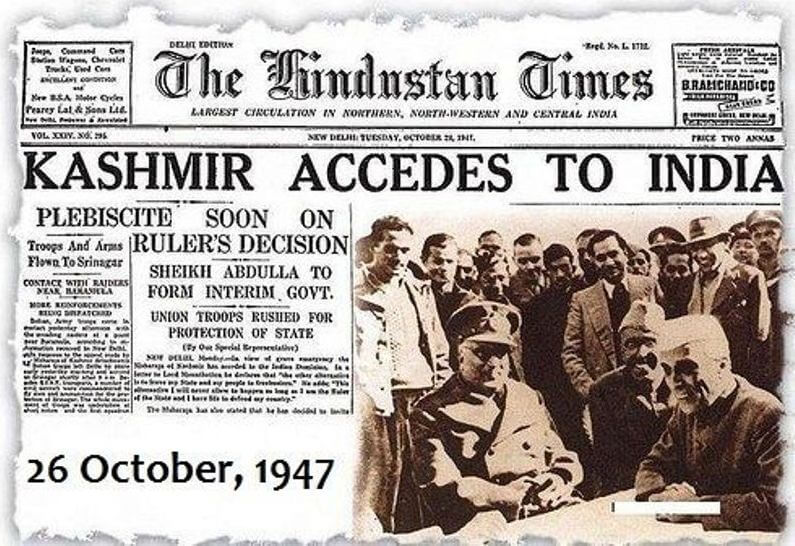
The Maharaja Hari Singh signed the Instrument of Accession to India on 26 October 1947 in Srinagar.
As soon as the accession documents were signed, the Indian Armed Force took over the stage to repulse Pakistan-supported tribal assault.
Indian and Pakistani forces thus fought their first war over Kashmir in 1947-48.
India successfully drove out most of the Pak-supported tribal militants from Kashmir occupation. However, one part of the State came under Pakistani control. India claims that this area is under illegal occupation. Pakistan describes this area as ‘ Azad Kashmir ’. India however, does not recognize this term. India uses the term Pak-occupied Kashmir (PoK) for the area of Kashmir under the control of Pakistan.
India brings the United Nations (UN) into the picture
India referred the dispute to the United Nations Security Council on 1 January 1948. Following the set-up of the United Nations Commission for India and Pakistan (UNCIP) , the UN Security Council passed Resolution 47 on 21 April 1948.
The UN Resolution was non-binding on India and Pakistan. However, this is what the UN resolution mentioned:
UN Resolution on Jammu and Kashmir
The UN resolutions clearly said :
- Pakistan is the aggressor in the state.
- Pakistan has to vacate all occupied territory in the state and hand over the vacated territory to India.
- India has to remove all its forces leaving aside enough to maintain law and order.
- India to conduct a plebiscite in the state.
Why has no Plebiscite or Referendum been held in Kashmir yet?
- The state of Jammu and Kashmir is defined as it existed on or before the invasion of Pakistan on 22nd October 1947. This includes the present territory of Pak-occupied Kashmir (POK), Gilgit, Baltistan, Jammu, Laddhak, and Kashmir Valley.
- Pakistan asked for time to vacate its occupation but it never complied.
- As nearly one-third of the state of Jammu and Kashmir is still under the occupation of Pakistan, it is a non-compliance of conditions leading to the plebiscite.
Sheikh Abdullah’s movement – Formal incorporation of Kashmir into the Indian Union
Kashmir’s first political party, the Muslim Conference, was formed in 1925, with Sheikh Abdullah as president. Later, in 1938, it was renamed as National Conference . The National Conference was a secular organization and had a long association with Congress. Sheikh Abdullah was a personal friend of some of the leading nationalist leaders including Nehru.
National Conference started a popular movement to get rid of the Maharaja. Sheikh Abdullah was the leader.
After Maharaja Hari Singh signed an ‘Instrument of Accession’ with the Government of India, Sheikh Abdullah took over as the Prime Minister of the State of J&K (the head of the government in the State was then called Prime Minister) in March 1948.
Sheikh Abdullah was against Jammu and Kashmir joining Pakistan. However, he took a pro-referendum stance and delayed the formal accession to India. The pro-Indian authorities dismissed the state government and arrested Prime Minister Sheikh Abdullah.
The new Jammu and Kashmir government ratified the accession to India. In 1957, Kashmir was formally incorporated into the Indian Union.
Kashmir Issue – External Disputes
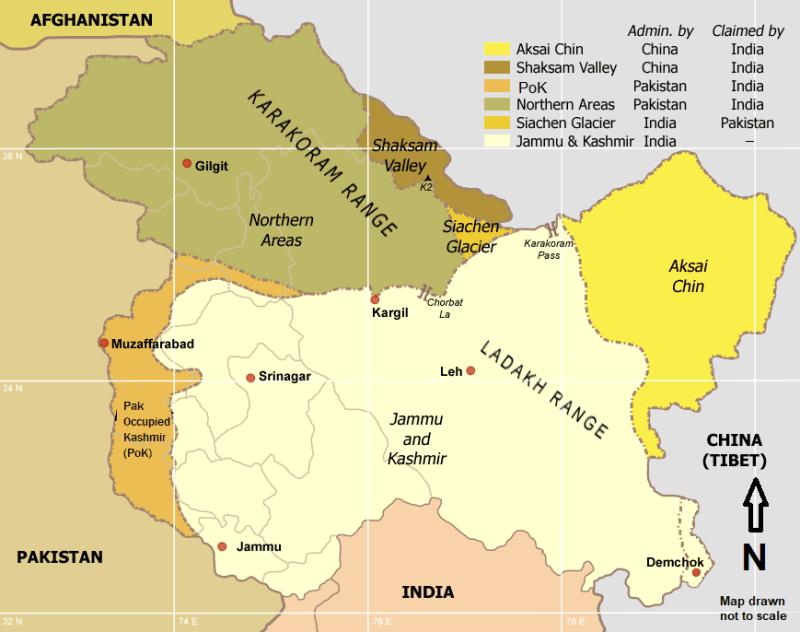
Externally, ever since 1947, Kashmir remained a major issue of conflict between India and Pakistan (and between India and China to a minor extent).
Pakistan has always claimed that the Kashmir valley should be part of Pakistan. The conflict resulted in 3 main wars between India and Pakistan – 1947, 1965, and 1971. A war-like situation erupted in 1998 as well (Kargil war).
Pakistan was not only the illegal occupant of the Kashmir region. China too started claiming parts of the princely state of Jammu and Kashmir.
By the 1950s, China started to gradually occupy the eastern Kashmir (Aksai Chin) . In 1962, India fought a war with China over its encroachments, however, China defeated India. To make matters worse, Pakistan ceded the Trans-Karakoram Tract of Kashmir (Saksham Valley) to China.
Kashmir Issue – Internal Disputes
Internally, there is a dispute about the status of Kashmir within the Indian Union.
Kashmir was given autonomy and a special status by Article 370 of the Indian Constitution . Articles like 370, 371, 35A , etc are connected with privileges given to Jammu and Kashmir.
What is the special status given to Jammu and Kashmir?
- Article 370 gives greater autonomy to Jammu and Kashmir compared to the other States of India.
- The State has its own Constitution.
- All provisions of the Indian Constitution do not apply to the State.
- Laws passed by the Parliament apply to J&K only if the State agrees.
- Non-Kashmiri Indians cannot buy property in Kashmir.
This special status has provoked two opposite reactions.
A section feels that Article 370 is not needed!
There is a section of people outside of J&K that believes that the special status of the State conferred by Article 370 does not allow full integration of the State with India. This section feels that Article 370 should, therefore, be revoked and J&K should be like any other State in India.
Another section feels that Article 370 is not enough!
Another section, mostly Kashmiris, believes that the autonomy conferred by Article 370 is not enough.
Major Grievances of Kashmiris:
Kashmiris have expressed at least three major grievances.
- First, the promise that Accession would be referred to the people of the State after the situation created by tribal invasion was normalized, has not been fulfilled. They demand a ‘Plebiscite’ at the earliest.
- Secondly, there is a feeling that the special federal status guaranteed by Article 370, has been eroded in practice. This has led to the demand for restoration of autonomy or ‘Greater State Autonomy’.
- Thirdly, it is felt that democracy which is practised in the rest of India has not been similarly institutionalised in the State of Jammu and Kashmir.
Politics since 1948 – Conflict between the Kashmir State Government and the Central Government of India
After taking over as the Prime Minister, Sheikh Abdullah initiated major land reforms and other policies that benefited ordinary people. But there was a growing difference between him and the central government about his position on Kashmir’s status. He was dismissed in 1953 and kept in detention for several years.
The leadership that succeeded him did not enjoy as much popular support and was able to rule the State mainly due to the support of the Centre. There were serious allegations of malpractices and rigging in various elections.
During most of the period between 1953 and 1974, the Congress party exercised a lot of influence on the politics of the State. A truncated National Conference (minus Sheikh Abdullah) remained in power with the active support of Congress for some time but later it merged with the Congress.
Thus Congress gained direct control over the government in the State.
In the meanwhile, there were several attempts to reach an agreement between Sheikh Abdullah and the Government of India.
Finally, in 1974 Indira Gandhi reached an agreement with Sheikh Abdullah and he became the Chief Minister of the State.
The Revival of National Conference (1977)
He revived the National Conference which was elected with a majority in the assembly elections held in 1977.
Sheikh Abdullah died in 1982 and the leadership of the National Conference went to his son, Farooq Abdullah, who became the Chief Minister.
But he was soon dismissed by the Governor and a breakaway faction of the National Conference came to power for a brief period.
The dismissal of Farooq Abdullah’s government due to the intervention of the Centre generated a feeling of resentment in Kashmir. The confidence that Kashmiris had developed in the democratic processes after the accord between Indira Gandhi and Sheikh Abdullah, received a setback.
The feeling that the Centre was intervening in the politics of the State was further strengthened when the National Conference in 1986 agreed to have an electoral alliance with the Congress, the ruling party in the Centre.
1987 Assembly Elections, Political Crisis, and Insurgency
It was in this environment that the 1987 Assembly election took place. The official results showed a massive victory for the National Conference-Congress alliance and Farooq Abdullah returned as Chief Minister.
However, it was widely believed that the results did not reflect the popular choice and that the entire election process was rigged.
A popular resentment had already been brewing in the State against the inefficient administration since the early 1980s. This was now augmented by the commonly prevailing feeling that democratic processes were being undermined at the behest of the Centre. This generated a political crisis in Kashmir which became severe with the rise of the insurgency.
By 1989, the State had come into the grip of a militant movement mobilized around the cause of a separate Kashmiri nation.
The insurgents got moral, material, and military support from Pakistan. The balance of influence had decisively tilted in Pakistan’s favor by the late 1980s, with people’s sympathy no longer with the Indian Union as it had been in 1947-48, 1965 or 1971.
The terrorists and militants drove out almost all the Hindus from the Kashmir valley, ensuring that a future plebiscite (if it happens) would be meaningless.
India imposed the Armed Forces Special Powers Act (AFSPA) in Jammu and Kashmir in 1990.
For several years, the State was under President’s rule and effectively under the control of the armed forces . Throughout the period from 1990, Jammu and Kashmir experienced violence at the hands of the insurgents and through army action.
1990 and Beyond – Growing Trust Deficit
After 1987, the pro-India sentiments of Kashmiri people tilted heavily towards Kashmiri Separatism. Pakistan, of course, added fuel to the fire – by giving moral and financial support to terrorists, militants, and insurgents. As a result, Kashmir frequently witnessed violence, curfew, stone-pelting, and firing between the troops of India and Pakistan across the Line of Control (LoC).
Thousands of soldiers, civilians, and militants have been killed in the uprising and the Indian crackdown since 1989.
Even though state elections were conducted, Kashmir did not return to normalcy before 1987 .
Assembly elections in the State were held only in 1996 in which the National Conference led by Farooq Abdullah came to power with a demand for regional autonomy for Jammu and Kashmir.
J&K experienced a very fair election in 2002. The National Conference failed to win a majority and was replaced by the People’s Democratic Party (PDP) and Congress coalition government.
In 2015, India’s ruling BJP party was sworn into government in Indian-administered Kashmir for the first time in coalition with the local People’s Democratic Party, with the latter’s Mufti Mohammad Sayeed as chief minister (followed by Mehbooba Mufti because of the death of her father and party founder). However, this coalition didn’t last for long.
Even though the Government of India is taking many steps to stop the insurgency and bring Kashmir back to normalcy, terrorist attacks like that in Pulwama have seriously hindered the peace process.
The Current Stand of India – Regarding the Kashmir Question
- No more mediation with the UN or any other other third parties.
- India and Pakistan should resolve issues through bilateral talks as agreed by the Simla Agreement.
- No Plebiscite in Kashmir unless Pakistan reverses the situation back to what was in 1947 (territory and demographics).
Who are the Kashmir Separatists?
- All Parties Hurriyat Conference
- Jammu Kashmir Liberation Front
- Harkat-ul-Jihad al-Islami
- Lashkar-e-Taiba
- Jaish-e-Mohammed
- Hizbul Mujahideen
- Harkat-ul-Mujahideen
- Ansar Ghazwat-ul-Hind Flag.png Ansar Ghazwat-ul-Hind (Since 2017)
What do Separatists demand?
Separatist politics which surfaced in Kashmir from 1989 has taken different forms and is made up of various strands.
- There is one strand of separatists who want a separate Kashmiri nation, independent of India and Pakistan.
- Then some groups want Kashmir to merge with Pakistan.
- Besides these, there is a third strand which wants greater autonomy for the people of the state within the Indian union .
Demand for intra-state autonomy
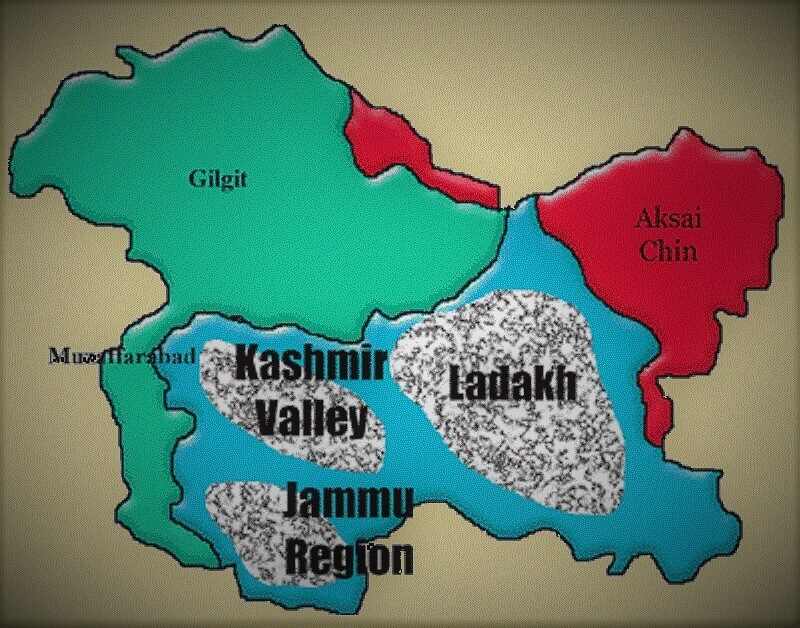
Even though the name of the state is Jammu and Kashmir (J&K), it comprises three social and political regions: Jammu, Kashmir, and Ladakh.
- Jammu – The Jammu region is a mix of foothills and plains, of Hindus, Muslims, and Sikhs and speakers of various languages.
- Kashmir – Kashmir Valley is the heart of the Kashmir region. The people are Kashmiri-speaking and are mostly Muslims. There is also a small Kashmiri-speaking Hindu minority.
- Ladakh – The Ladakh region is mountainous, and has a very small population which is equally divided between Buddhists and Muslims. Ladakh is divided into two main regions – Leh and Kargil.
It should also be noted that out of the 3 main administrative divisions – Jammu, Kashmir, and Ladakh – insurgency and demand for independence is high only in the Kashmir Valley. Most of the people in Jammu and Ladakh still wish to be part of India, even though they demand autonomy differently. They often complain of neglect and backwardness. The demand for intra-state autonomy is as strong as the demand for State autonomy in the regions of Jammu and Ladakh.
Article 370: Changes made via Presidential order of 2019
On 5 August 2019, Home Minister Amit Shah announced in the Rajya Sabha (upper house of the Indian Parliament) that the President of India had issued The Constitution (Application to Jammu and Kashmir) Order, 2019 (C.O. 272) under Article 370, superseding the Constitution (Application to Jammu and Kashmir) Order, 1954.
The order stated that all the provisions of the Indian Constitution applied to Jammu and Kashmir.
While the 1954 order specified that only some articles of the Indian constitution to apply to the state, the new order removed all such restrictions.
This in effect meant that the separate Constitution of Jammu and Kashmir stood abrogated.
The President issued the order with the “concurrence of the Government of State of Jammu and Kashmir”, which meant the Governor appointed by the Union government.
Change of status: Jammu and Kashmir Reorganisation Act, 2019
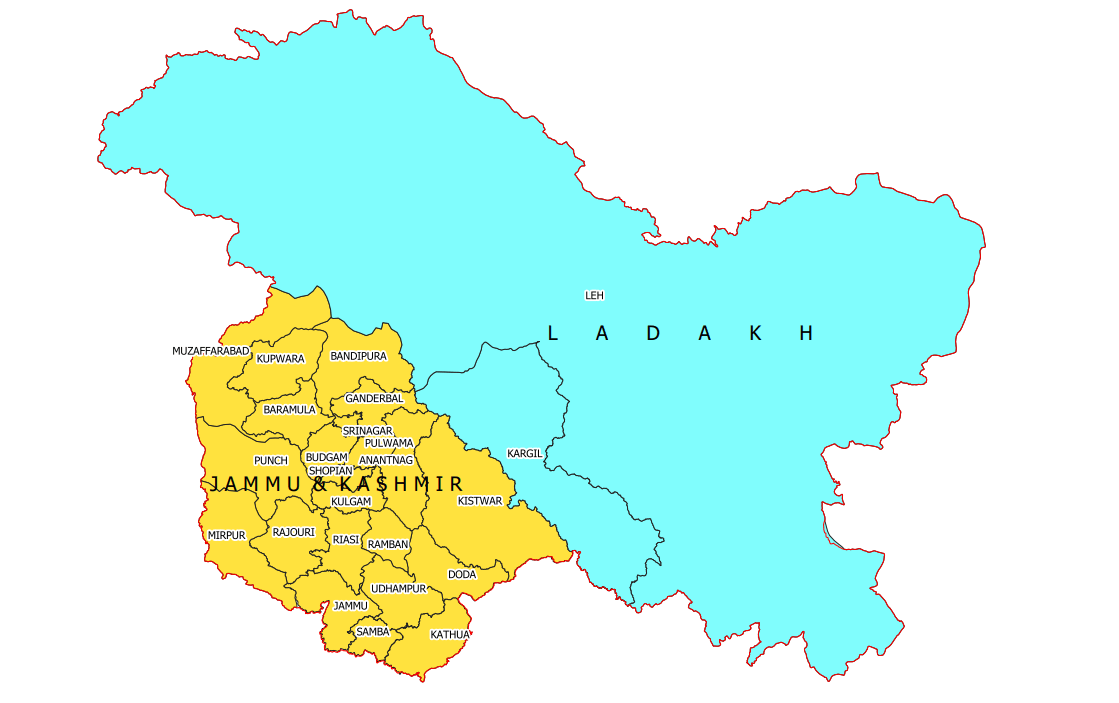
After the Government of India repealed the special status accorded to Jammu and Kashmir under Article 370 of the Indian constitution in 2019, the Parliament of India passed the Jammu and Kashmir Reorganisation Act, which contained provisions that dissolved the state and reorganized it into two union territories – Jammu and Kashmir in the west and Ladakh in the east.
The two union territories came into existence on 31 October 2019, which was celebrated as National Unity Day.
The union territory of Jammu and Kashmir was proposed to have a legislature under the bill whereas the union territory of Ladakh is proposed to not have one.
Urge for Peace
The initial period of popular support for militancy has now given way to the urge for peace.
The Centre has started negotiations with various separatist groups. Instead of demanding a separate nation, most of the separatists in the dialogue are trying to re-negotiate a relationship of the State with India.
The Kashmir issue – has multiple dimensions – external and internal; inter-state as well as intra-state. Not even the separatists are on the same ground – their demands are different.
The princely state of Jammu and Kashmir which was under the control of British India – is now not entirely with India. Pakistan and China too now occupy a significant portion of the territories of the erstwhile princely state.
Of course, the Kashmir problem also includes the issue of Kashmiri identity known as Kashmiriyat. However, almost every state in India has its own identity – Tamil Nadu, Karnataka, West Bengal, or Kerala. However, the people in each of these states even when seeing themselves as Tamilians, Kannadagans, Bengalis or Malayalis are also able to see the bigger picture – they identify themselves as Indians.
Jammu and Kashmir is one of the living examples of plural society and politics. Not only are there diversities of all kinds (religious, cultural, linguistic, ethnic, tribal) but there are also divergent political aspirations.
Unfortunately, from the perspective of the youth of Kashmir, there is a growing trust deficit. It’s a hard reality that Jammu and Kashmir never functioned like other Indian states since its accession to India. It had given higher autonomy initially, however, it got eroded in practice.
The first step to solving the Kashmir issue is to identify the problems behind the alienation of Kashmir. Here are some of them:
- Mishandling of the Kashmir Issue by the successive Central governments of India – which includes frequent dismissal of State Assemblies.
- The state governments of Kashmir failed to distribute the benefits of growth and development to every area of Kashmir.
- The terrorist and military outfits in Pakistan have been distancing the youth of Kashmir from the democratic form of the Indian government.
- The regular presence of the Indian Armed Force or CAPF in the Kashmir interiors, and the misuse of provisions like ASFPA.
To find a solution to the Kashmir issue – all stakeholders should be considered.
What is the need of the hour is proper integration of Kashmir, Jammu, and Ladakh with India. Integration should not be seen in a limited dimension of territory. India should be able to win the hearts of the people of Kashmir.
Only time can tell about the success of the changes made concerning the provisions of Article 370.
Kashmir was and still is an integral part of India. It has a plural and secular culture – just like the rest of India. Urgent steps should be taken to bridge the gaps of trust deficit in the minds of Kashmiri youth. All Kashmiris should get the due share in the growth story of India. Like all other states in India, there should be adequate political autonomy in Jammu and Kashmir.
Violence, terrorism, and killings are never the answer – be it on any side. What do you think?
Read: Ladakh statehood

Best-Selling ClearIAS Courses
Upsc prelims cum mains (pcm) gs course: unbeatable batch 2025 (online), rs.75000 rs.29999, upsc prelims cum mains (pcm) gs course: ultimate batch 2025 (online), rs.95000 rs.49999, upsc prelims cum mains (pcm) gs course: ultimate batch 2026 (online), rs.115000 rs.59999, upsc prelims cum mains (pcm) gs course: ultimate batch 2027 (online), rs.125000 rs.69999.
About Alex Andrews George
Alex Andrews George is a mentor, author, and social entrepreneur. Alex is the founder of ClearIAS and one of the expert Civil Service Exam Trainers in India.
He is the author of many best-seller books like 'Important Judgments that transformed India' and 'Important Acts that transformed India'.
A trusted mentor and pioneer in online training , Alex's guidance, strategies, study-materials, and mock-exams have helped many aspirants to become IAS, IPS, and IFS officers.
Reader Interactions
March 6, 2019 at 6:50 pm
The separatist themselves don’t want this situation to have a positive outcome as it will subsequently deteriorate/hamper their “political” stance which they’ve nurtured since a long time.
February 11, 2023 at 7:29 pm
I never seen a article like this…its amazing date wise i m from Kashmir i nvr understand Kashmir isssue , Kashmir history from beginning…but today i understand full 🌝 thanks to the author of this article 😊
March 6, 2019 at 7:30 pm
As long as radical brainwashed of youth continues…nothing can be done, first shut down all those radical institutions & then bring education that teaches about secularism & India’s beauty & achievements!
March 6, 2019 at 7:43 pm
kashmiri youth mind are washed out by these separatist…and some militant group ..work opportunity should be given to the youths of kashmir alike other states of india ….Empty mind see only a way to destruction…..
March 6, 2019 at 11:58 pm
The real situation of J&K can be assessed only by hearing the voices of the common people, the constitutional arrangements like Article 370, Article 35A & IoA must be respected to keep the relationship intact.
March 18, 2019 at 11:34 pm
Common people with normal situation ab toh majority Muslim log ka hi hai…. pehle un hinduwo ko bulo jinko waha se bhga diya gya …tb na brabar ka faisla hoga
March 7, 2019 at 9:52 am
there is another angle to look into this dispute and that is religion. religion play a major role in building and developing the behaviour of the society.
March 7, 2019 at 10:31 am
Yes, I do agree that wars, disputes, killing will no longer be a way to provide an efficient solution to Kashmir issue.
March 8, 2019 at 12:21 pm
wonderful article….!! what i believe is ..us Indians should stand together for Kashmir… and make people of Kashmir know that though we are 1000’s of kilometers away we still stand for them will be their strength…Apart from all the political drama they should know that a simple spark in kashmir will cause a wildfire in kanyakumari.. The role of govt here is the root cause of all the issues if u ask me .. what were you doing while the kidnapper lure the kid with the candy …? now indian govt should respect the kashmiri’s give them the hope and gain trust.. a lot of bloodshed ,mutilated bodies , power abuse , women abuse … give them hope …show them we love them .. youth from other states understand the kashmiris show them the support.. show them why they should be a part of india …
March 8, 2019 at 5:20 pm
For the violence to stop in Kashmir and preventing this problem to further aggravate development plans, projects should be well reached in the state so that the youth is engaged in something productive rather than destructive work. First of all, the politicisation of the State situation should be avoided.
March 13, 2019 at 11:31 pm
This is not the solution of problem,but give the right of people.As it is mentioned is article that Kashmir was a princely state,it has right to what they want,the Kashmir dispute has only one solution come India and Pakistan forward and give rights to Jammu and Kashmir people what they want,and destroy this illegal occupied.
March 14, 2019 at 2:54 pm
Further plubicite may useful for kashmiris yo choose their will…
March 27, 2019 at 7:14 pm
Your assumption of Kashmir being an integral part of India because the it was a part of The Mughal Empire is akin to the assumption that India is an integral part of Great Britain because it was a British colony once. That is ridiculous! The problem would not be solved till India accepts the fact that Kashmir is not an integral part of India. You cannot blame Pakistan for it then because Pakistan was as much ‘India’ once as new India is. So morally, historically, Politically and logically, by your argument, Pakistan is nowhere wrong to claim Kashmir for itself!
April 7, 2019 at 6:48 pm
but chirag The Government of Pakistan agrees to have Standstill Agreement with Jammu and Kashmir but india didn’t. So, Pakistan is wrong as it was a the first one who attack….in 1947 october after that indian government helps J&K and our military took over the charge.
April 7, 2019 at 9:33 pm
state politician are taking due benefit of the prevailing situation in jammu kashmir. They are making their vote bank at the cost of common public. Center should make efforts to ground level development through job creation employment generation education and overall development of state. mare education is not solution even the highly educated students after getting no source of income has diverted their route which mislead the other growing youth. Stone pelting is source of income for some public because they are paid for this for which politicians and other extremists are responsible as they bargain with center for normalcy of situation.
July 10, 2019 at 10:56 am
all is messed up because of british government gave 3 choice instead of two
August 2, 2019 at 2:47 am
Very good article, Alex! 🙂
August 9, 2019 at 8:30 pm
The only thing matters is that J&K belongs to India, anyone can claim it but won’t get even a stone of it. (At least till the plebiscite is done with all the Kashmiris taking part including the one who had left or removed from Kashmir). They do deserve to take their own decision with all due respect but including all the Hindus, Muslims, Sikhs and Buddhists.
August 14, 2019 at 6:31 pm
This is the best article I have ever read……!!! Really helpful in making a notes on Kashmir…..Thankyou very much…..!!!!!!
August 19, 2019 at 6:42 pm
Now the minds of kashmir people have been washed with the continuous presence of separatists and the Pak sponsored terrorism. No more plebiscites are needed to be given to these people. Indian government and the constitution is supreme. They have revoked 370 to bring the J & K into mainstream for all round development of J&K and its people. Pak does not have any right to interfere in our affairs, since its accession to India.
January 24, 2020 at 9:12 pm
Really good notes, grateful thanks to clearias team
February 9, 2020 at 6:21 pm
If Indian government wanted to integrated Kashmir into Indian Union, they should behave like human towards Kashmiri people who suffered from torture, disappearance, rapped by Indian Army from decades. Even Kashmiri youth experience torture, mob lynching by rest of indian people and although India wanted to integrate land of Kashmir not the people.
March 30, 2020 at 12:07 am
Can I download all of this in pdf format?
April 22, 2020 at 9:16 pm
Thank you sir
May 21, 2020 at 1:25 pm
It’s a very good article and has explained the J&K issue as easily as possible yet maintained the details. My look over the recent amendments on the J&K issue has changed, and it looks like a step that will work for the people in the long run (however not in the short term).
September 14, 2020 at 12:23 pm
Now come to know more about J & K issue… Contents of several book in one article.. Separatists,militants,terrorists, defunct politicians should be treated hard with central / State agencies … Hope for peace not only in valley… But in all parts including jammu,Kashmir & Ladakh……
October 27, 2020 at 12:44 am
I have a simple question. Even if both Pakistan and India want and agree on something. Should that be the solution, or should it be what the people want. To me, whether you like it or not, its the right of the Kashmiris to decide what they want for their future. Give them that right, thats the only fair solution.
And if you are not bothered by what is fair then the alternative is to go with the powerful and war is the way to find who is stronger.
March 21, 2022 at 3:38 pm
This Article is Baseless and Far From Ground Reality of Our Kashmir Nation , Kashmir Is not a integral or Vein of Any Nation wether is India or Pakistan , Kashmir Is Independent Before Birth of India or Pakistan.. Due to Continues occupation by Non Kashmirs Wehter is Muslim or Non Muslims , We Kashmirs Fight against the Occupation From years, still we are under Occupation joinlty by India paksitain and China ,, We Kashmirs are Peaceful Community between three Nation , we Lost more then 1 lakh we are wintess of crimes done by Non Kashmirs, we kashmiri Never agaist any Pakistain or India , but we never allow any indian or pakitain Interfercne in out kashmir , due to interference of India and Pakistan is responsible for destruction of our kashmir nation , We Peaple of kashmir never accept any occupation , 1000 political Drama playing by tri nation till date in our kashmir..
we Kashmiri appeal to Good and responsible Citizen of India and Pakistaini , both-side people are misguided regarding the Kashmir nation, the Ground Reality is different.. we Kashmiri respect both side nation as guest , we welcome every country peoples visit our kashmir people but we never accept India and pakistain occupation and we never forget the crimes of India and pakistain .
April 27, 2023 at 5:08 pm
Please update your notes. This is brilliantly done.
July 26, 2023 at 7:08 pm
Unbiased, good analysis and effectively presented. Hope the powers to be can affect the policy ideas presented here. Thanks!
Leave a Reply Cancel reply
Your email address will not be published. Required fields are marked *
Don’t lose out without playing the right game!
Follow the ClearIAS Prelims cum Mains (PCM) Integrated Approach.
UPSC Online Preparation
- Union Public Service Commission (UPSC)
- Indian Administrative Service (IAS)
- Indian Police Service (IPS)
- IAS Exam Eligibility
- UPSC Free Study Materials
- UPSC Exam Guidance
- UPSC Prelims Test Series
- UPSC Syllabus
- UPSC Online
- UPSC Prelims
- UPSC Interview
- UPSC Toppers
- UPSC Previous Year Qns
- UPSC Age Calculator
- UPSC Calendar 2025
- About ClearIAS
- ClearIAS Programs
- ClearIAS Fee Structure
- IAS Coaching
- UPSC Coaching
- UPSC Online Coaching
- ClearIAS Blog
- Important Updates
- Announcements
- Book Review
- ClearIAS App
- Work with us
- Advertise with us
- Privacy Policy
- Terms and Conditions
- Talk to Your Mentor
Featured on

and many more...
ClearIAS Programs: Admissions Open
Thank You 🙌
UPSC CSE 2025: On May 25, 2025
Subscribe ClearIAS YouTube Channel

Get free study materials. Don’t miss ClearIAS updates.
Subscribe Now

IAS/IPS/IFS Online Coaching: Target CSE 2025

Cover the entire syllabus of UPSC CSE Prelims and Mains systematically.
- From the Editor
- Our Contributors
- For Submissions
- Creative Commons

V eteran civil rights activist and journalist Gautam Navlakha, who surrendered before National Intelligence Agency (NIA) in New Delhi on April 14 following a Supreme Court order on the Bhima-Koregaon case , has had a long and deep engagement with Kashmir.
As an activist and journalist, Navlakha has visited and worked in Kashmir for decades. Anyone who knows him in Kashmir knows how he’s always spoken out, and written about, their political and human rights. He’s also produced a body of work documenting the changing political situation and rights violations in Kashmir over the years. He’s also written extensively on the impact of heavy militarization on the economy and on the lives of people in Kashmir. Navlakha has equally been a part of many ground-breaking, fact-finding delegations and reports on Jammu and Kashmir, some of which are not available online.
While his writings on Kashmir largely focus on state violence and militarization in the region, his writings on the Maoist insurgency focus on both the sociology and organization of insurgency itself.
About a decade ago, I remember Navlakha speaking in a civil society seminar in Srinagar. The pain in his voice showed a rare concern and deep empathy for the struggles of people in Kashmir.
He also spoke about how it’s probably the only movement where so many people have suffered so much and over many decades without achieving anything substantial in return.
“I can’t understand why Kashmir doesn’t get anything concrete despite all the sacrifices people have made here over decades,” he said, wanting the people to also think about protecting their lives while also resisting abusive power. “You ask any sacrifice and people have made it here. You deserve a better future now.”
I’m reminded of what Belarusian writer Svetlana Alexievich, who was awarded the 2015 Nobel Prize in Literature, said in her moving Nobel Lecture which also sums up the sense of loss and pain in Kashmir.
“Suffering is our capital, our natural resource,” she said. “Not oil or gas – but suffering. It is the only thing we are able to produce consistently. I’m always looking for the answer: why doesn’t our suffering convert into freedom?”
Here’s a list of 10 essays by Gautam Navlakha on Kashmir, with short excerpts and online links to full essays, which were published in different publications, many of them in the reputed Economic and Political Weekly, dating back to the early 1990s.
10 Must-Read Essays on Kashmir by Gautam Navlakha
“Bharat’s Kashmir War” by Gautam Navlakha (EPW, December 21, 1991)
This paper attempts to clarify the Kashmir imbroglio by investigating its genesis in the context of the Indian state’s responses.
“In most Indian writings, however, the characterisation of the movement in Kashmir as communal and fundamentalist proceeds from the argument that the Kashmiri Pandits are being hounded out of Kashmir and since they do not share the desire for referendum the demand cannot be ‘nationalist’ since nationalism is a secular identity. The contrary is however true. Nationalism is not the opposite of religious identity. The point of commonality is not just the religious zeal.”
Bharat’s Kashmir War In the last two years a lot has been written on Kashmir. But arguments on all sides have been more in the nature of assertions rather than informed reasoning. J…
“Kashmir: At the Edge of the Possible” by Gautam Navlakha (Economic and Political Weekly, September 17, 1994)
“…since the Indian army cannot defeat militancy and because the government is not trying hard enough for a political solution, not even when political openings come its way, and with involvement of international agencies being increasingly perceived as the only way in which the Indian government can be dissuaded from persisting with its militaristic response to what has been and remains a political problem, the prospect of peace without the association of Hurriyet to work out the framework and modality of a referendum remains remote.”
Kashmir At the Edge of the Possible Kashmir: At the Edge of the Possible Gautam Navlakha The emergence of the militant organisation Harkatul Ansar holds the prospect of mindless violence of a kind one sees in Afghanistan, but the blame for this must rest squarely on the government, on its total lack of foresight.
“India Turns Clock Back” Back by Gautam Navlakha (EPW, May 22, 1993)
“It needs reiteration that chauvinism and anti-Muslim prejudice all over India found sustenance in lies about destruction of temples in Kashmir or in ignorance of the facts of Kashmiri Pandit migration from the valley which actually accelerated after Jagmohan took over in January 1990. This should act as a reminder that if the policy of attrition is not controlled back, the consequences point in the direction of a xenophobic build-up which will pave the way eventually for ‘demo-graphic Indianisation’.”
KASHMIR- India Turns Clock Back The decision to impose army rule in Kashmir, in effect if not formally, represents a tragic turn of policy, as much for India as for the people of Kashmir. Step by step the government has been moving in precisely the direction which the BJP and the Hindu chauvinists have been urging it to take.
“Chrar-e-Sharief: Victory for Hardliners on Both Sides” by Gautam Navlakha (EPW, May 20, 1995)
“On May 9, the day before the destruction of Chrar-e-Sharief, the right and left in parliament unitedly condemned the government for ‘kneeling’ before the militants. Not a word was said about the Kashmiri people’s alienation and the violence perpetrated against them. Indeed there was not even the usual vacuous talk of the political process.”
Chrar-e-Sharief-Victory for Hardliners on Both Sides The government’s version of the hunting of Chrar-e-Sharief and the events leading up to it are full of holes, but more important is it that the destruction of the shrine has dealt a blow to the efforts of Kashmiri leaders such as Shabir Shah and Yasin Malik who Have been working courageously to bring the gun under control in Kashmir.
“It’s Never Too Late to Do the Right Thing” by Gautam Navlakha (EPW, July 29, 2000)
“History teaches that people are not mere spectators who cannot influence the course of events. When successive governments failed the citizens by dividing the people, then it would be a mistake to leave every-thing to the discretion of the government. It is for us to fight for a just and honourable peace. Irrespective of what the government or militant leadership do in J&K, actions of solidarity can also stem the tide of communal polarisation. But before everything else we must welcome and lend unqualified support to the Kashmiris because it is the inalienable right of all of us to revolt against oppression to defend our dignity and freedom. It is only then our concerns will acquire meaning, and be taken seriously. To the extent people make their own histories the choice is ours.”
Kashmir : It’s Never Too Late to Do the Right Thing An obsession with territorial integrity has undermined the singular importance of the politics of solidarity, preventing an appreciation of the ground realities in Kashmir. The government’s current offer to hold unconditional talks with the militant leadership, while commendable, cannot succeed unless there is a recognition of the urgent need to begin the long process of gaining the confidence of the Kashmiris.
State of Jammu and Kashmir’s Economy” by Gautam Navlakha (EPW, October 6, 2007)
“The Economic Survey for J&K does show how despite the disruptions and privations caused by war, economic performance has improved. Quite apart from sweeping statements about employment in horticulture and the importance of tourism, it does, however, skirt the fact that without addressing the issue of occupation of land by troops and restrictions placed on the use of water resources, both intricately linked to a political solution, problems will remain in the path of realising the full economic potential of the state.”
State of Jammu and Kashmir’s Economy The 2006-07 Economic Survey for Jammu and Kashmir reveals that despite the privations of conflict, the performance of the economy has improved in recent years. However, unless the two political issues of occupation of land and restrictions on the use of the state’s water resources are removed, the full economic potential of the state will not be realised.
“Doctrine for Sub-conventional Operations: A Critique” (Economic and Political Weekly, April 13, 2007)
In late 2006, the Indian army released its first ever doctrine on sub-conventional operations, i e, internal operations. This article critiques the document. “It is worth nothing what the Army Chief told the students of Sainik School in Thiruvananthapuram on February 17, 2007. According to him, the army’s fight is against the “divisive forces” and “our cause is just” and “we fight to win”. Win in this context means to suppress people.”
Doctrine for Sub-Conventional Operations: A Critique on JSTOR In late 2006, the Indian army released its first ever doctrine on sub-conventional operations, i e, internal operations. This article critiques the document.
“Kashmir: State Cultivation of the Amarnath Yatra” by Gautam Navlakha (Monthly Review, Aug 08, 2008)
“Arguably, when the yatra was halted between 1991 and 1996 due to the threat by a section of the militants it played into the hands of the extreme right wing elements in Indian society who have since then played an integral role in mobilising large numbers of pilgrims. However, it is equally important to note that earlier, schoolchildren and college youth used to act as volunteers and provide assistance to the yatris. Even when this was discontinued after 1996, the main indigenous militant organisation the Hizbul Mujahideen and Muslim Janbaz Force always supported the yatra and consistently demonstrated its opposition towards those who tried to disrupt it. And even today there is no section of people who opposes the yatra. What they resent is the horrendously jingoistic turn that it has taken under the SASB.”
MR Online | Kashmir: State Cultivation of the Amarnath Yatra The origins of the conflagration in June in Kashmir on forest land allocation for construction of facilities for the Amarnath yatra lie in open state promotion of the pilgrimage. The yatra has caused considerable damage to the economy and ecology of the area. The high-handed actions of the Shri Amarnath Shrine Board only aggravated the situation.
“From the Killing Fields of Kashmir to the Finishing Line” by Gautam Navlakha (Sanhati, October 10, 2010)
“Truth and demand for justice are on the side of the Kashmiri people. It would be a sad day were these battles won after so much of sacrifice, is allowed to be squandered for illusory gains at the behest of mealy-mouthed Indian ruling classes. There can be no replacement for right of self-determination. It is in Indian people’s interest, for our own democratic struggle, that we stand by this demand of the Kashmiri people. Defeat of oppressors in Kashmir, unlike the doomsayers, will strengthen our struggle.”
From the Killing Fields of Kashmir to the Finishing Line By Gautam Navlakha Where armed conflicts have gone on for a long period (decades) and where negotiations have been used by the State to win time or tire out opponents, or talks are deadlocked or cannot ensure compliance with whatever solution is reached, then making a reference to the people is the most sensible way […]
“The Kashmir Question: Nation-state, War, and Religion” by Gautam Navlakha (Indian Cultural Forum, Feb 2018)
“India’s working people cannot emancipate selves if they do not come out strongly against the persecution of the Kashmiri people at the hand of the same bourgeoisie nation-state which exploits and oppresses Indian people in general. While the Indian public may not influence external developments vis a vis Pakistan or China, they certainly can affect domestic perceptions and transform the terms of debate. Therefore, it matters how India’s progressives steer their political course and whether they can provide an alternate perspective on Kashmir to counter the myopic official discourse. It needs no reiteration that it is “never too late to do the right thing.”
The Kashmir Question: Nation-State, War and Religion – Gautam Navlakha Gautam Navlakha
Relevant Links
‘My Hope Rests on a Speedy and Fair Trial’: Gautam Navlakha Before His Surrender The Supreme Court recently rejected the bail applications of scholar and activist Gautam Navlakha, who was booked under the Unlawful Activities (Prevention) Act, or UAPA for allegedly fomenting violence during during the Bhima Koregaon event. The top court gave him and scholar Anand Teltumbde one week to surrender.
India Covid-19: SC Decision To Send HRDs Gautam Navlakha And Anand Teltumbde To Jail Is Cruel And Disappointing – Amnesty International India Amnesty International India Bangalore / New Delhi: 10 April 2020 12:39 pm Amid the spread of COVID-19, the Supreme Court of India’s order directing the arrest and imprisonment of two human rights defenders, Anand Teltumbde and Gautam Navlakha within a week, is disappointing.
Why is India targeting writers during the coronavirus pandemic? | Priyamvada Gopal and Salil Tripathi As a lethal virus scorches its way across continents, the leftwing Indian rights campaigner Gautam Navlakha has been reminding us of the words of Leonard Cohen, urging people to speak up for the right things: “There is a crack/a crack in everything, that’s how light gets in.”
‘New Low in India’s Political History’: PUDR Condemns Anand Teltumbde, Gautam Navlakha’s Arrests New Delhi: Condemning the arrest of social activists and intellectuals Anand Teltumbde and Gautam Navlakha on Tuesday, the People’s Union for Democratic Rights (PUDR) said that this “attempt to browbeat rights activists” marked a “deep and scathing new low in the political history of contemporary India”.
India: Activists Detained for Peaceful Dissent (New York) – Indian authorities on April 14, 2020 detained two rights activists who have been critics of government policies, Human Rights Watch said today. The government should immediately drop all charges under a counterterrorism law against Anand Teltumbde and Gautam Navlakha for allegedly inciting caste-based violence along with other activists during a demonstration in Maharashtra state in 2017.
Mounting international concern over detention of civil rights activists in India in the midst of the COVID-19 pandemic Over 5,000 Individuals and 15 Organizations Sign Global Statement of Support for Dr. Anand Teltumbde and Mr. Gautam Navlakha On 16 March 2020, a Supreme Court bench comprising the judges Arun Mishra and Mukeshkumar Rasikbhai Shah rejected the anticipatory bail pleas of the civil-rights activist Gautam Navlakha and the writer Anand Teltumbde, in relation to the violence at Bhima Koregaon in January 2018.
Stand in Solidarity with Anand Teltumbde and Gautam Navlakha Stand in Solidarity with Anand Teltumbde and Gautam Navlakha Statement by Activists, Academics and Concerned Citizens In August 2018, the Pune Police implicated Prof. Anand Teltumbde and Gautam Navlakha with other human right activists and lawyers in the now-infamous fabricated Elgar Parishad case.
Journalist Gautam Navlakha tells CPJ he fears imprisonment amid COVID-19 pandemic New Delhi, April 9, 2020 — Indian authorities should stop pursuing the arrest of journalist Gautam Navlakha, and should cease holding journalists in jail during the COVID-19 pandemic, the Committee to Protect Journalists said today.
Clampdown On Dissent Continues During The Covid-19 Pandemic In India The clampdown on dissent in India continues. Even during a pandemic, the Government of India is seeing to that targeting those critical of the government are being targeted. When hard-won rights to expression and peaceful protest are weakened, everyone stands to lose.
Human Rights Defender Gautam Navlakha’s Letter Before His Arrest As I prepare to Ieave to surrender before the NIA headquarters in Delhi I am glad that Justice Arun Mishra and Justice Indira Banerjee gave me another week of freedom when they passed the order on April 8, 2020. A week of freedom means a lot in my condition, even in the age of lockdown.
Global Solidarity Staement for Dr. Anand Teltumbde and Gautam Navlakha – Jamhoor This is a time sensitive petition for the immediate release of Anand Teltumbde and Gautam Navlakha, two of India’s foremost civil rights activists and public intellectuals. Please read and sign this petition here: Global Solidarity Statement for Dr. Anand Teltumbde and Gautam Navlakha .
Human rights groups denounce Indian activists’ arrest as crackdown on dissent – La Prensa Latina Media New Delhi, Apr 15 (efe-epa).- Human rights nonprofits on Wednesday came down hard against the Indian government a day after the arrest of scholar Anand Teltumbde and rights activist Gautam Navlakha under an anti-terrorism law for allegedly inciting violence during a protest in 2018, calling it a clampdown on dissent.
96c03acb00 – United States Department of State India is a multiparty, federal, parliamentary democracy with a bicameral legislature. The president, elected by an electoral college composed of the state assemblies and parliament, is the head of state, and the prime minister is the head of government.
Under UAPA, Process Itself Becomes Punishment, Writes Activist Gautam Navlakha Before Surrendering | NewsClick As the country remembers Dr Bhimrao Ambedkar on the occasion of his birth anniversary, civil rights activists Gautam Navlakha and Anand Teltumbde, who were booked under the draconian UAPA in relation to the Bhima Koregaon violence in 2018, are set to surrender to the police.
Indian columnist arrested on trumped-up “Maoism” charge | Reporters without borders Reporters Without Borders (RSF) calls for the immediate and unconditional release of Gautam Navlakha, a well-known columnist and human rights defender who, despite serious humanitarian concerns, has been jailed on a flimsy charge brought by India’s counter-terrorism police, the National Investigation Agency (NIA).
Persecution of rights activists and voices of dissent in India Recently, in a series of synchronized raids carried throughout India, various human rights activists and vocal critics of the ruling government were arrested under the Unlawful Activities Prevention Act (UAPA), an anti-terror law. These arrests have been widely criticized for being politically motivated as they are aimed at curbing the right of free speech and dissent or criticism towards the government.
Dalit leaders condemn Anand Teltumbde’s arrest on 14 April-Ambedkar Jayanti On 16 March 2020, a Supreme Court bench comprising the judges Arun Mishra and Mukeshkumar Rasikbhai Shah rejected the anticipatory bail pleas of the civil-rights activist Gautam Navlakha and the writer Teltumbde, in relation to the violence at Bhima Koregaon in January 2018.
UK Rights Organisations condemn arrest of Anand Teltumbde and Gautam Navlakha UK Rights Organisations condemn the imminent arrest of Prof Dr Anand Teltumbde and Gautam Navlakha Demand prompt release of all political and democratic rights activists in Indian jails 08 April 2020 The police in the State of Maharashtra, India, acting at the behest of the central BJP Hindutva government, is forcing the arrest of Professor […]
Statement by Hindus for Human Rights and Global Indian Progressive Alliance Protesting the Arrest of Dr. Anand Teltumbde and Gautam Navlakha – Hindus For Human Rights Dr. Anand Teltumbde is a highly respected and revered scholar and human rights defender. Along with his comrade in justice work, Gautam Navlakha, Dr. Teltumbde will be arrested today on demonstrably fabricated charges related to the Bhima Koregaon case.
Dalit Leaders, Political Representatives Condemn Dr Teltumbde’s Imminent Arrest on Ambedkar Jayanti | NewsClick Ahead of the Anand Teltumbde’s surrender on April 14 [also the ocaasion of B R Ambedkar’s birth anniversary] in accordance with the Supreme Court order, Dalit, Adivasi, OBC and minority leaders have demanded that he be allowed “to live and write, to be a free spirit that enlivens our democratic selves”.
MASS condemn arrest of Gautam Navalakha and Anand Teltumbe Guwahati: The Manab Adhikar Sangram Samiti (MASS) is disturbed and dismayed by the Supreme Court of India’s decision to allow for the detention of civil rights activist Gautam Navalakha and Anand Teltumbe after August 14,2020. Both had been implicated in Bhima Korgoan case of 2018, where many Dalit activists were hurt in rioting by mobs supported by powerful local politicians.
‘A tragedy for India’: Author Arundhati Roy on arrests of activists Anand Teltumbde, Gautam Navlakha ‘They have both been accused of outlandish crimes.’
In Solidarity with and Appeal to Acquit Prof. Anand Teltumbde In Solidarity with and Appeal to Acquit Prof. Anand Teltumbde Statement by IIMA faculty, students and alumni Over 280 students, faculty members and alumni of Indian Institute of Management, Ahmedabad (IIMA), have signed a statement in solidarity with their illustrious alumnus, Anand Teltumbde who apart from being a corporate leader and teacher has done so much to the society.
About the Contributor

Majid Maqbool

Essay on Jammu and Kashmir Issue
Students are often asked to write an essay on Jammu and Kashmir Issue in their schools and colleges. And if you’re also looking for the same, we have created 100-word, 250-word, and 500-word essays on the topic.
Let’s take a look…
100 Words Essay on Jammu and Kashmir Issue
Introduction.
Jammu and Kashmir is a region in northern India with a complex history. It has been a subject of dispute between India, Pakistan, and China since 1947.
Historical Background
Jammu and Kashmir was a princely state during British rule. During partition in 1947, it had the option to join either India or Pakistan.
The Dispute
The ruler of Jammu and Kashmir chose to accede to India. This decision led to a conflict between India and Pakistan, sparking several wars.
Current Scenario
Today, the region is divided between the three nations. The issue remains unresolved, causing tension and conflict.
250 Words Essay on Jammu and Kashmir Issue
Jammu and Kashmir (J&K), a region of immense geopolitical significance, has been a contentious issue between India and Pakistan since their partition in 1947. The dispute originates from the complex historical, political, and socio-cultural dynamics of the region.
Historical Context
The princely state of J&K, predominantly Muslim but ruled by a Hindu Maharaja, acceded to India post-partition under certain conditions. The Instrument of Accession, signed by Maharaja Hari Singh, promised a high degree of autonomy to J&K, which was later enshrined in Article 370 of the Indian Constitution.
Conflict and International Dimensions
The region has witnessed multiple wars, insurgency, and a constant state of tension. Pakistan, claiming the entire state based on its Muslim majority, has sought international intervention, while India insists it’s a bilateral issue. The conflict has also caught the attention of global powers, given its strategic location and nuclear dimension.
Recent Developments
In August 2019, the Indian government abrogated Article 370, revoking J&K’s special status. This move has added a new layer to the dispute, intensifying the debate on autonomy, integration, and human rights.
The Jammu and Kashmir issue is not merely a territorial dispute but a complex mesh of historical, political, and socio-cultural aspects. It is a challenge that demands a nuanced understanding and an approach that respects the aspirations of the people of J&K, while ensuring geopolitical stability.
500 Words Essay on Jammu and Kashmir Issue
Jammu and Kashmir, an idyllic region nestled in the northernmost part of India, has been a hotbed of political and territorial disputes since the partition of India and Pakistan in 1947. The issue is complex, involving historical, political, and socio-cultural aspects that have shaped the region’s current dynamics.
At the time of partition, the princely state of Jammu and Kashmir, under the rule of Maharaja Hari Singh, chose to remain independent. However, an invasion by tribal militias from Pakistan prompted the Maharaja to accede to India, which led to the first Indo-Pak war. The United Nations intervened, leading to a ceasefire and the establishment of a Line of Control (LoC), dividing the region into Indian-administered Jammu and Kashmir and Pakistan-administered Azad Kashmir and Gilgit-Baltistan.
Political Dimensions
The political dimension of the Jammu and Kashmir issue is characterized by divergent narratives. India maintains that the region is an integral part of its territory, while Pakistan asserts that the majority-Muslim region should have been part of its territory post-partition. There is also a third narrative, primarily advocated by separatist groups within the region, demanding complete independence or self-determination.
Article 370 and 35A
Article 370 and 35A of the Indian Constitution granted Jammu and Kashmir a special status, allowing it to have its own constitution and flag, and restricting outsiders from buying property in the state. However, in August 2019, the Indian government abrogated these articles, integrating the region fully into India. This move sparked widespread criticism and protests, both domestically and internationally.
Socio-Cultural Implications
The dispute over Jammu and Kashmir has profound socio-cultural implications. The region has witnessed several bouts of violence, leading to loss of life and property, and creating deep-seated fear and mistrust among communities. The issue has also led to the displacement of several communities, most notably the Kashmiri Pandits, who were forced to flee the valley during the insurgency in the 1990s.
International Aspects
The Jammu and Kashmir issue has significant international ramifications. Apart from being a point of contention between India and Pakistan, it has also drawn the attention of global powers, particularly China, which controls the Aksai Chin area of Ladakh. The region’s strategic location, coupled with its rich natural resources, makes it a focal point in geopolitics.
The Jammu and Kashmir issue is a complex amalgamation of historical, political, and socio-cultural factors. Resolution of this dispute requires a nuanced understanding of these dimensions, coupled with a commitment to dialogue and diplomacy. It is essential to prioritize the welfare of the region’s inhabitants, ensuring their rights, aspirations, and cultural identities are respected in any future settlement.
That’s it! I hope the essay helped you.
If you’re looking for more, here are essays on other interesting topics:
- Essay on Winter in Kashmir
- Essay on Protect Nature
- Essay on Living in Harmony With Nature
Apart from these, you can look at all the essays by clicking here .
Happy studying!
Leave a Reply Cancel reply
Your email address will not be published. Required fields are marked *
Save my name, email, and website in this browser for the next time I comment.

45,000+ students realised their study abroad dream with us. Take the first step today
Meet top uk universities from the comfort of your home, here’s your new year gift, one app for all your, study abroad needs, start your journey, track your progress, grow with the community and so much more.

Verification Code
An OTP has been sent to your registered mobile no. Please verify

Thanks for your comment !
Our team will review it before it's shown to our readers.

- School Education /
Essay on Kashmir: History and Beauty in 600+ Words

- Updated on
- January 20, 2024
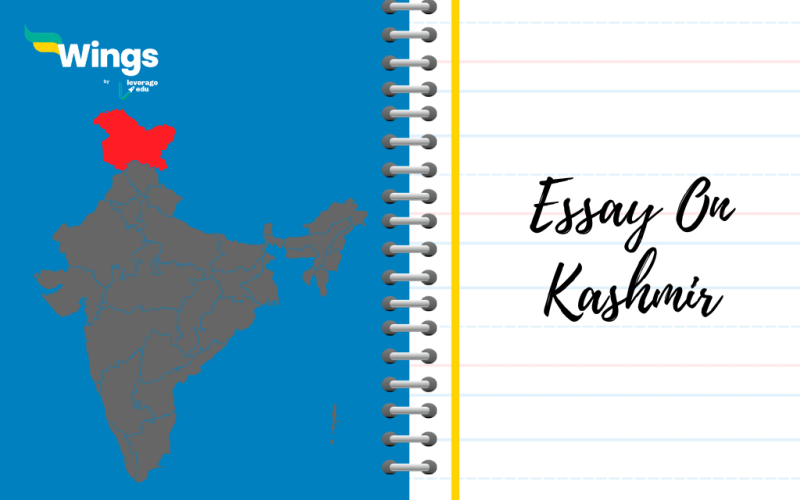
Essay on Kashmir for Students: Kashmir is a region situated between India and Pakistan in South Asia. It is believed that the name Kashmir originated from the word ‘Ka’ which means water, and ‘shimera’ to desiccate.
The story of Kashmir is complex and has historical, cultural, and political dimensions. Over the years, many rulers and empires, like the Mauryas , Kushans , and Mughals have influenced the paradise of the Earth. The region especially had the special influence of Mauryan ruler Ashoka who contributed to the cultural as well as the architectural heritage of the region.
Cultural Diversity of Kashmir
Kashmir is a region that has a rich history and ancient roots. The place has witnessed the rise and fall of many dynasties, such as the Mauryas , Kushnas , and Guptas . On top of that, these dynasties contributed to the cultural and geographic location of Kashmir, which includes the influence of the Silk Road and the blend of Hindu, Buddhist, and later Islamic influences.
Kashmir Issue
The dispute related to the sharing of borders didn’t stop after Independence. Whether it was India, Pakistan, or China, tensions related to the disputes of the region always created a heat of fire between the countries that led to wars. The list of some important wars are as follows:
1. First Indo-Pak War (1947-1948) : Fought for Jammu Kashmir shortly after India’s independence.
2. Sino-Indian War (1962): A conflict between India and China for the territorial region Aksai Chin.
3. The War of (1965): Fought mainly over Kashmir.
4. Kargil War (1999): A conflict between India and Pakistan in the Kargil district of Jammu and Kashmir.
Article 370 Scrapped
Geographically, Kashmir lies in the northwestern region of the Indian continent. Its total area is around 225,000 square kilometers, which is comparatively larger than the member countries of the United States.
Out of the total area, 85,800 square kilometers have been subject to dispute between India and Pakistan since 1947. It is important to note that the areas with conflict consist of major portions called the Northern, Southern, and Southeastern portions. The 30 percent of the northern part comprises Azad Kashmir and Gilgit-Baltistan and is administered by Pakistan.
India controls the portion which is more than 55 percent of the area of the land. The area consists of Jammu and Kashmir, Ladakh, Kashmir Valley, and Siachen Glacier which is located in the southern and southeastern portions of India. The area is divided by a line of control and has been under conflict since 1972.
Also Read: Speech on Article 370
Sadly, the people living near the International Border and the Line of Control (LoC) in Jammu and Kashmir pose not only a life threat but also do not have a stable life. Replacement and relocation affect the people living in the line of control not affect the people physically but also psychologically and socially aspects. In a survey conducted by the National Library of Medicine 94 percent of the participants recognize stress. Furthermore, the youth population was facing stress and anxiety regularly.
However, a historic decision from the Supreme Court of India that nullified Articles 370 and 35A and permitted the state to have its constitution, flag, and government except in defense, foreign affairs, and communications decisions. After the decision, many initiatives were taken by the government of India to strengthen the democratic rule of the state. Schools, colleges, and universities were opened regularly in the union territories to develop the youth academically, socially, and as well as physically.
Furthermore, strict measures to control criminal assaults such as stone pelting have started showing positive impacts on the continuance use of technologies such as mobile networks, and internet activities. Further, the discontinuity of Technology has started showing positive impacts on the lifestyle of people. Regular opening of schools, colleges, and universities, on the one hand, is helping the students to have good career prospects.
Additionally, the fear-free environment that further increases tourist activities will further improve the local economy and contribute to the local as well as the national economy of the country.
Also Read: Essay on Indian Independence Day
Kashmir is also called the Paradise on Earth. The region is blessed with natural beauty, including snow-capped mountains and green and beautiful valleys. The region is surrounded by two countries, which are Pakistan and China.
Kashmir is famous for Dal Lake, Pashmina Shawls, beautiful Mughal gardens and pilgrimage sites of Amarnath and Vaishno Devi.
According to a traditional story, Ka means water and shimira means Desiccate.
Kashmir is known as the ‘Paradise on Earth.’
Related Blogs
This was all about the essay on Kashmir. We hope this essay on Kashmir covers all the details for school students. For more information on such interesting topics, visit our essay writing page and follow Leverage Edu.
Deepika Joshi
Deepika Joshi is an experienced content writer with educational and informative content expertise. She has hands-on experience in Education, Study Abroad and EdTech SaaS. Her strengths lie in conducting thorough research and analysis to provide accurate and up-to-date information to readers. She enjoys staying updated on new skills and knowledge, particularly in the education domain. In her free time, she loves to read articles, and blogs related to her field to expand her expertise further. In her personal life, she loves creative writing and aspires to connect with innovative people who have fresh ideas to offer.
Leave a Reply Cancel reply
Save my name, email, and website in this browser for the next time I comment.
Contact no. *

Connect With Us
45,000+ students realised their study abroad dream with us. take the first step today..

Resend OTP in

Need help with?
Study abroad.
UK, Canada, US & More
IELTS, GRE, GMAT & More
Scholarship, Loans & Forex
Country Preference
New Zealand
Which English test are you planning to take?
Which academic test are you planning to take.
Not Sure yet
When are you planning to take the exam?
Already booked my exam slot
Within 2 Months
Want to learn about the test
Which Degree do you wish to pursue?
When do you want to start studying abroad.
January 2025
September 2025
What is your budget to study abroad?

How would you describe this article ?
Please rate this article
We would like to hear more.
Have something on your mind?

Make your study abroad dream a reality in January 2022 with
India's Biggest Virtual University Fair

Essex Direct Admission Day
Why attend .

Don't Miss Out

English Literature Notes
- Winter's Tales
- Paradise Lost
- Ancient Mariner
- Ode to Autumn
- Heart of Darkness
- Things Fall Apart
- The Old Man And the Sea
- William Shakespeare
- Christopher Marlow
Mind Refreshing & Soul Touching Quotes
- Shakespeare Quotes
- O Neil Quotes
- Quotes by Plato
- Aristotle Quotes
- Arms and the Man
- Dr. Faustus
- Quotes On Love
- Quotes On Fate
- Quotes On Life
- Quotes On Women
- Top Ten Quotes
- The Cherry Orchard
Learn Essay Writing from Sample Essays
- Democracy and Dictatorship
- War on Terrorism
- Importance of Education
- Importance of English
- More Essays
Learn Grammar, The Easy Way
Grammar basics.
- Parts of Speech
- Noun and Pronoun
- Adjective and Adverb
- Forms of Verb
- Preposition in English
- English Punctuation
- English Articles
- Sentence Structure
Learn Tenses
- Indefinite Tenses
- Continuous Tenses
- Perfect Tenses
Passive Tenses
- Active & Passive Voice
- Learn Passive
- Using Since,for
- Our Mission
- Privacy Policy
- Terms and Conditions
- Site Search
- Arms And The Man
- Hedda Gabler
- Importance of Being Earnest
- Mourning Becomes Electra
- Oedipus Rex
- The Boy Comes Home
- Waiting For Godot
- Winters Tales
- After Apple Picking-Summary
- After Apple Picking-Theme
- All The World's a Stage
- Ariel by Sylvia Plath
- Because I Could Not Stop for Death
- Coleridge-Romantic Poet
- Daffodils by Wordsworth
- Departure and Arrival
- Hawk's Monologue
- IF by Rudyard Kipling
- John Keats-Romantic Poet
- Leisure-William Davies
- Metaphysical Poetry
- Mystic Poetry-William Blake
- New Year Resolutions
- Ode to Autumn by John Keats
- Ode to Grecian Urn-Summary
- Ode to Grecian Urn Critical-Appreciation
- Ode to A Nightingale by John Keats
- One Art by Elizabeth Bishop
- Poetry-Philip Larkin
- Poetry-Surrey and Wyatt
- Poetry-Ted Hughes
- Rebel - D.J Enright
- Solitary Reaper
- Songs of Innocence & Experience
- The Ancient Mariner
- The Huntsman
- The Rape of The Lock
- The Second Coming: Yeats
- When I have Fears
- Blessings of Science
- Comparing Democracy & Dictatorship
- Concept of Liberty
- Democracy-Is It Best
- Effects of Smoking
- Fashion Among Students
- Father's Day Importance
- Friendship and Society
- International-Day-against-Drug-Abuse-Illicit-Trafficking
- Kashmir Issue
- Role of Women in National Development
- Mobile Phones: A Blessing Or A Curse
- Politics and Third World Countries
- Problem of illiteracy
- Terrorism and Pakistan
- Tsunami: A Tale of Destruction
- Truth: It's Importance and Man
- The War on Terrorism
- UNO And World Peace
- Women Education
- World Population Day, an overview
- Author Quotes
- Quotes by Topic
- Book Quotes - Literature
- Grammar - An Insight
- English Sentence Structure
- Active and Passive
- Using Since & For
Essay Writing Samples for Graduates
- Comparing Democracy and Dictatorship
- Democracy: The Best Governing System
Write an essay on Kashmir Issue
The essay on kashmir issue and dispute discusses the recognition of this world problem by uno and the three parties to it, kashmir issue: an outline:.

Recent & Popular Posts
- English Urdu Dictionary
- Top Quotes on Life
- Top Quotes on Love
- Famous Truth Quotes
- Finest Quotes from Othello
- Shakespeare Great Quotes
- The Necklace Notes
Playwrights
- Samuel Beckett
- Oscar Wilde
- Anton Chekhov
- George Bernard Shaw
- More Dramas
Plays' Notes
Popular quotes topic.
- Life Best Quotes
- Love Best Quotes
- Iqbal Best Poetry
- Man Best Quotes
- Truth Best Quotes
Poems' Notes
- Paradise-Lost
- Songs: Innocence/Experience
- Ode to A Nightingale
- After Apple Picking
Share-RiseNotes!
Copyright © 2007-2024 RiseNotes! All Rights Reserved. Privacy Policy Terms and Conditions

IMAGES
VIDEO
COMMENTS
This post contains an Essay on Kashmir Issue with Outline and Quotations for the students of Class 10, Class 12, FSc, B.A, BSc, Graduation, and others. The same essay could be written under the title Essay on Kashmir Issue or Few Lines about Kashmir.
11 Dec 2023. In a major setback to Kashmiri political groups, India’s Supreme Court has upheld a 2019 decision by Prime Minister Narendra Modi’s government to revoke special status for...
Kashmir Issue has multiple dimensions - external and internal; inter-state as well as intra-state. What makes the Question so complex?
Majid Maqbool curates a list of 10 must-read essays on Kashmir by Gautam Navlakha, taken from a larger body of work that spans decades of Gautam's engagement with Kashmir.
Jammu and Kashmir (J&K), a region of immense geopolitical significance, has been a contentious issue between India and Pakistan since their partition in 1947. The dispute originates from the complex historical, political, and socio-cultural dynamics of the region.
The Kashmir issue stands as one of the most protracted and complex conflicts in the modern world, presenting a challenge at the intersection of geopolitics, nationalism, and human rights. This paper delves into the multifaceted dimensions of the Kashmir issue, examining its historical
Kashmir Issue. The dispute related to the sharing of borders didn’t stop after Independence. Whether it was India, Pakistan, or China, tensions related to the disputes of the region always created a heat of fire between the countries that led to wars. The list of some important wars are as follows: 1.
for almost 60 years now, the Kashmir issue between india and Pakistan has dominated security concerns on the indian sub-continent, and fuelled weapons and nuclear proliferation in and around the region. india and Pakistan have already been at war on several occasions, and given that both countries have nuclear capabilities, Kashmir has been char...
The Kashmir issue has been one of the biggest conflicts in the Far East since 1947. The Indian-Pakistani actions against each other over the years did not bring results. The geographical location and religious variety within the Kashmir valley make it an on-going issue.
The essay on Kashmir Issue and dispute discusses the recognition of this world problem by UNO and the three parties to it. Kashmir Issue: An Outline: (1) Introduction: the beginning of an issue (2) U.N's efforts to resolve it (3) lndo-pak stance on this problem (4) Present situation in Kashmir